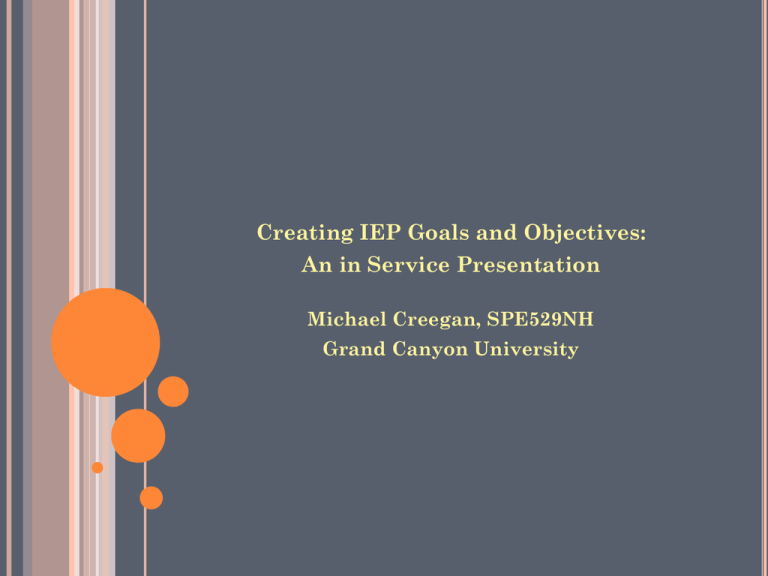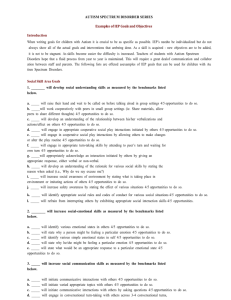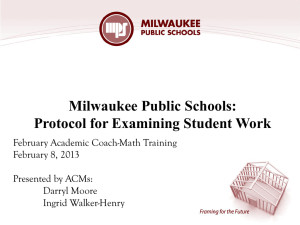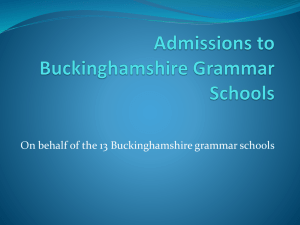Creating IEP Goals and Objectives.ppt
advertisement

Creating IEP Goals and Objectives: An in Service Presentation Michael Creegan, SPE529NH Grand Canyon University Characteristics of Children with Disabilities Depending on the disability present and the age of the student, there are a number of common characteristics that may be present. These characteristics can be broken down into three categories… Examples of LD Characteristics Cognitive Characteristics -Cognitive and Metacognitive Deficits -Low Academic Achievement Affective Characteristics -Poor Social Skills -Poor Self-Concept Poor Motivation -Debilitating Mood States -Poor Memory -Attention Problems -Perceptual Disorders http://www.belmont.k12.wi.us/faculty2/klein/characteristics.htm Behavioral Characteristics -Adaptive Behavioral Deficits -Disruptive Behavior -Withdrawal Students with Disabilities: Classroom Behavior Trends The behavioral characteristics of students with disabilities may manifest themselves in a number of ways in the classroom setting. Possible Behaviors at the Middle School Level Disconnect from faculty and peers Vocal or physical outburst Inability to communicate basic needs verbally “Running” Fixation on specific themes Difficulty focusing on academics Target Student The purpose of this meeting is to inform educators on a new student, James, who will be receiving special education services in our district. As an overview; James is an incoming student to our school district diagnosed with autism. James will be placed in a 12:1:1, self-contained, special education classroom. After adjusting to the district, the goal is to include James in the mainstream classroom as much as possible. Learners with Autism There is a wide example of behavioral characteristics that learners with autism exhibit. These will vary depending on the severity of the disease in the particular student. Common Characteristics of Learners with Autism o Inappropriate laughing or giggling o Difficulty in expressing needs; may use gestures o No real fear of dangers o Inappropriate attachments to objects o Apparent insensitivity to pain o Insistence on sameness o Sustained unusual or repetitive play; uneven physical or verbal skills oMay avoid eye contact o Echoes words or phrases o Inappropriate response or no response to sound oMay prefer to be alone http://www.autisminfo.com/characteristics.html o Difficulty in interacting with others Improving Communication Skills Of James’ many academic and behavioral goals, improving communication skills is a top priority. Specific goals for James will include; Successfully use conversational strips to initiate, maintain, and end conversation Successfully use proper greetings and routine conversational questions Improve eye contact while engaged in conversation Using functional questions including “what”, “where”, and “who” Raising hand to initiate an academic question Raising hand to ask for basic needs Impact on Student Learning James’ communication deficits are a hindrance upon his academic performance. By learning to use functional questioning and appropriate questioning procedures, James will; Learn to communicate basic needs Communicate to teachers when he is frustrated or does not understand content Appropriately communicate with teachers and peers Use verbal language to resolve problems rather than verbal or physical outbursts Present Level of Academic Performance Currently James is performing below grade level in most academic areas. James will benefit from the use visual and verbal cues offered from the classroom teacher and his 1:1 aide. Reading and Writing James currently reads at a 2nd grade level and needs extra time and support when given assessments with written directions James has difficulty with handwriting activities and benefits from thick pencils, as they are easier for him to grasp and hold correctly Math Math is James’ strongest subject. James successfully states times tables 2-10. James successfully groups and carries over when given basic computation problems up to 4 digits James has difficulty with word problems and basic algebra equations Language Skills James needs the support of sentence strips, conversational scripts, icons, verbal cues, and questioning by teachers to effectively communicate basic needs Measureable Annual Goals James’ Measurable Annual Goals will include; Speech and Language James will practice and use various conversational scripts to maintain a conversational exchange with appropriate body orientation and eye contact. James will identify common statements, match statements with situations, and use those statements when interacting with peers Evaluation Criteria- 8 out of 10 trials James will initiate and end conversations with 80% accuracy Evaluation Criteria- 8 out of 10 trials Evaluation Criteria- 8 out of 10 trials James will identify solution to a problem when given a choice of 3 written responses Evaluation Criteria- 8 out of 10 trials Additional Measureable Annual Goals Other James will effectively use a tripod grasp when writing with no more than 3 verbal cues James will use proper letter sizing and spacing when writing with no more than 3 verbal cues Evaluation Criteria- 8 out of 10 trials James will identify solution to a problem when given a choice of 3 written responses Evaluation Criteria- 60% over 1 week James will use relaxation techniques such as deep breathing when feeling frustrated Evaluation Criteria- 60% over 1 week Evaluation Criteria- 80% over 1 week James will solve math problems with the following concepts; ordinal numbers, fractions, up to 4 digit addition, subtraction, and multiplication, word problems, and read simple graphs Evaluation Criteria- 80% over 1 week How The Goals will be Measured The primary responsibility of measuring annual goals will fall upon; SpEd teacher Classroom teacher Various Service Providers (where appropriate) Goals will be measured on their specified percentages using a checklist and portfolio system. When assessing each goal, the evaluator will mark each trial with either a check stating that the objective was completed, or a minus stating that the objective was not completed. Benchmarks and Short Term Objectives James’ short term goals and objectives will focus on his behavioral adjustment to his new classroom. Short Term Objectives James will successfully participate in all classroom routines, after 1 week of instruction James will appropriately communicate with his new peers and teachers when engaged, after 1 week of instruction James will maintain a functional workspace in the classroom, and locker in the hallway Additional Special Education Services James will have a permanent 1:1 aide. Additionally, he has been recommended for the following special education services Adapted physical education Freq- 10 times monthly for 40 mins Music Therapy Freq- 2 times weekly for 30 mins Occupational Therapy Freq- 2 times weekly for 30 mins Speech/Language Therapy Freq- 3 times weekly for 30 mins Modification of Current Services James will have the following modifications made to the current services offered to him Rather than attending mainstream physical education, James will attend adaptive physical education James will use the aide of visual and verbal cues during assessment James will be given extended time (2x) on assessments The IEP Team IDEA 2004 defines the IEP Team as the following individuals: The parents of the child; Not less than one regular education teacher of the child Not less than one special education teacher of the child A representative of the public agency who is qualified to provide, or supervise the provision of, specially designed instruction to meet the unique needs of children with disabilities. An individual who can interpret the instructional implications of evaluation results Other individuals who have knowledge or special expertise regarding the child, including related services personnel as appropriate (invited at the discretion of the parent or the agency) The child with a disability (when appropriate). http://www.nichcy.org/EducateChildren/IEP/Pages/team.aspx Attendance Procedures Attendance is not necessary when it is determined un-necessary by the parents of the child and the education agency because the team member’s specialty area will not be discussed at the meeting A team member may be excused from the meeting when their curricular area is being addressed if written consent is given by the parents or if a written contribution of material is given to the IEP team prior to the meeting When Parents are Absent Parents will be contacted by phone, and the meeting will be delayed 15 min to allow time for the parent to arrive If the parent does not attend the meeting after 15 min the meeting will proceed as scheduled If the parent does not attend the meeting in full, the SpEd. Teacher will communicate the minutes of the IEP meeting both verbally and in writing http://www.wrightslaw.com/idea/art/iep.team.members.htm









